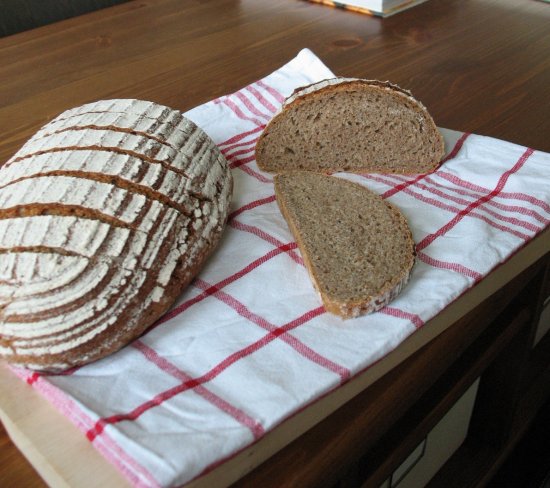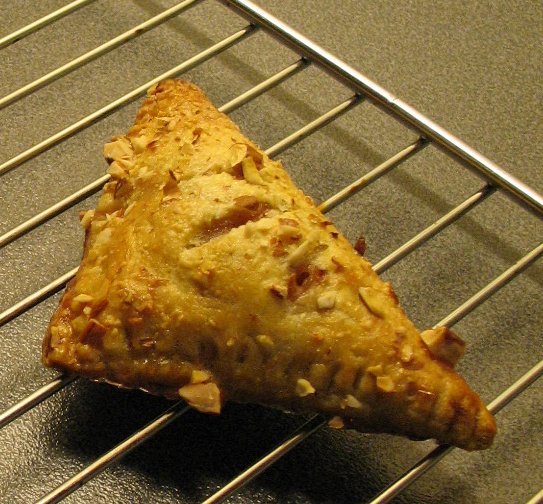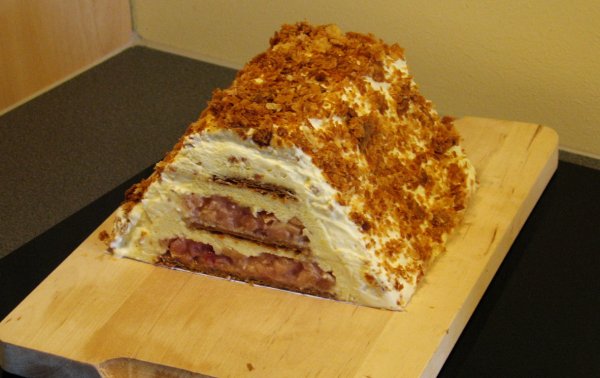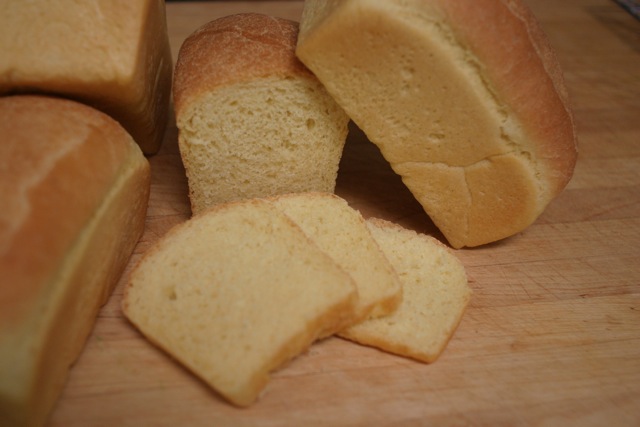Here's one of my favourite rye loaves:

The loaf is a 70% rye with a hot rye meal soaker. The hydration is around 80%, and I put approx. 15% of the total flour in the soaker. The pre-gelatinized flour contribues to a very soft, moist and tender crumb, and gives the loaf excellent keeping qualities. The rest of the flour is whole rye (about 55%) and ordinary bread flour (30%). I make it with a firm white starter and a tiny speck of fresh yeast, about the size of a small pea (just under 2 gr.), so the loaf develops a nice, round flavour during a 2 hr bulk fermentation. Final proof is approx. 1hr 15 mins.

This loaf is a decent compromise: It has the nice flavour of rye, and the added bread flour contributes significant strength and lightness to the loaf. You could add different bread spices or herbs to it, but I think I prefer it plain.
For dinner, I opted for the feuillete with salmon tartar from Roux' pastry book. Well... I have been out of puff pastry for a couple of weeks, and I needed a good excuse to make some more ;-) Besides, I'd just seen a video of a chef making the quick/blitz/rough version of puff pastry, and I would like to have a go at it myself. I've made the classic version before (and I'm still blown away by the puffing power of classic puff), but never the quick version. The procedure is simple enough: Basically a buttery pie dough that is given turns, and brief rests in the fridge in between. One shouldn't do too many turns with quick puff, as that tends to break down the rough layers and diminish the volume of the end product. Enough of that... so I did four single turns on the pastry while the rye bulk fermented. No pain at all, and I was thoroughly surprised over how quick (and dirty) the method is.
I cut off a bit of the dough this afternoon to make dinner. The dough is rolled into a thin circle, and this is then rolled in granulated sugar. The sugar caramelizes in the oven, and adds a unique sweet crunch to the feuillete at each bite. Sweet sugar crunch, fresh salmon and buttery feuillete went down remarkably well in my book :)

Roux writes that the rough version bakes up to about 75% of the volume attained by correctly rolled classic puff. Doing the rough version felt a bit like cheating, I'll gladly admit it, but for such savoury applications, I don't think it matters that much. I'll definitely go with the classic one for any ambitious dessert, but the rough version is very handy and comes together very quickly.
The inevitable: Left overs and scrap puff. Oh boy. What to do? Can't throw it away, can you? It's all butter and flour-y goodness, innit? My local grocery store had some perky raspberries the other day, so I thought a mille-feuille would finish off a long day.


Added June 27: I still had some of the rough puff pastry in my fridge, and figured I could use the rest to make some apple turnovers and a dessert this weekend. I picked up a nice batch of Royal Gala apples at the local grocery and made an apple filling. Instead of the usual vanilla/cinnamon flavoured filling, I tried a recipe flavoured with lemon juice and a liberal sprinkling of Calvados. *Yum*

So, for the turnovers, I sprinkled them with sugar and some chopped almonds just before baking. I think they turned out alright, but you can see that the rough puff version doesn't puff up as much as the classic one. Still tastes good, though.

For the dessert this weekend, I opted for a recipe in Friberg's pastry book that I've been drooling over for a long time, but not had the opportunity to make before now. It's something he calls puff pastry apple points, and it's an interesting variation on the usual mille-feuilles. The puff pastry is baked as a thin sheet (i.e. weighed down by a second baking sheet on top for the first 15 mins.), and is cut into three consecutively thinner strips. The points are then made by stacking layers of puff, the Calvados apple filling and a Calvados cream. The whole thing is iced with ordinary whipped cream, and decorated with crumbs of left over baked puff. I think it turned out alright! It tasted great anyway, with a marked Calvados taste due to both the filling and the Calvados cream. By the way, here's how it's supposed to look: Photo from the book. Note that I took the photo before cutting into individual servings... slicing these mille-feuilles tend to become... messy. Pressing through the cream and cutting with a serrated knife through the pastry strips should do the trick.

















